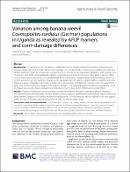| dc.contributor.author | Twesigye, Charles K. | |
| dc.contributor.author | Ssekatawa, Kenneth | |
| dc.contributor.author | Kiggundu, Andrew | |
| dc.contributor.author | Tushemereirwe, Wilberforce | |
| dc.contributor.author | Matovu, Enock | |
| dc.date.accessioned | 2022-02-02T10:47:57Z | |
| dc.date.available | 2022-02-02T10:47:57Z | |
| dc.date.issued | 2018-10-23 | |
| dc.identifier.citation | Twesigy,Charles K...et al (2018). Variation among banana weevil Cosmopolites sordidus (Germar) populations in Uganda as revealed by AFLP markers and corm damage differences. Agriculture & Food Security.https://doi.org/10.1186/s40066-018-0227-8. | en_US |
| dc.identifier.uri | https://doi.org/10.1186/s40066-018-0227-8 | |
| dc.identifier.uri | https://kyuspace.kyu.ac.ug/xmlui/handle/20.500.12504/347 | |
| dc.description | 16 p. : col. | en_US |
| dc.description.abstract | The banana weevil Cosmopolites sordidus (Germar) is a major production constraint of bananas and
plantains (Musa spp.) in the world. Differences in damage levels and pesticide response across regions led to the postulation
that there might be considerable variation between banana weevil populations (biotypes) with varying levels
of virulence. One of the most sustainable options for banana weevil control is the use of host plant resistance. While
new resistant varieties are being developed through both conventional crossbreeding and biotechnology, there is a
need to assess the genetic variation of banana weevil populations from eastern, central, southern, southwestern and
midwest regions of Uganda to determine whether there are biotypes with different virulence levels. This would help
guide new control strategies to target all the possible biotypes. The amplified fragment length polymorphism (AFLP)
technique was used to analyze population genetic diversity using four primer combinations (EcoRI/MSeI).
Results: Analysis of molecular variance results presented no evidence to support significant genetic variability
among the banana weevil populations from eastern, central, southern, southwestern and midwest regions. Practically,
all the genetic variation was found to reside within populations (97% for sites and 98% for regions), with only approximately
3% and 2% residing among populations of sites and regions, respectively.
Conclusions and recommendations: AFLP markers clustered the banana weevils into two distinct populations consequently
supporting the hypothesis of possible presence of banana weevil biotypes in Uganda. However, attempts
should be made to make follow-up studies on the seemingly unique population of eastern Uganda using more
robust molecular techniques to establish whether the eastern Uganda population constitutes a different biotype. | en_US |
| dc.language.iso | en | en_US |
| dc.publisher | Agriculture & Food Security. | en_US |
| dc.subject | AFLP markers | en_US |
| dc.subject | Banana weevil | en_US |
| dc.subject | Biotypes | en_US |
| dc.subject | Cosmopolites sordidus | en_US |
| dc.subject | Genetic variation | en_US |
| dc.title | Variation among banana weevil cosmopolites sordidus (Germar) populations in Uganda as revealed by AFLP markers and corm damage differences | en_US |
| dc.type | Article | en_US |

